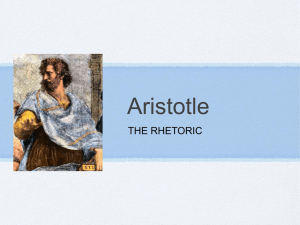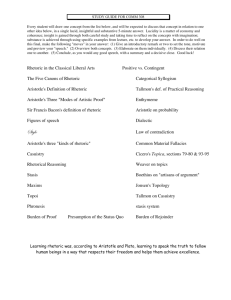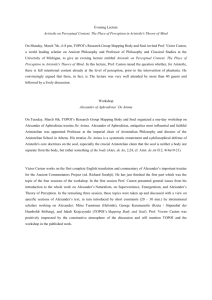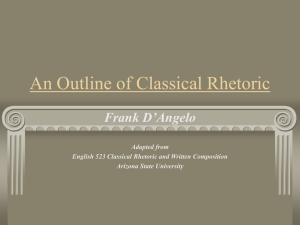Topoi - 8170
advertisement
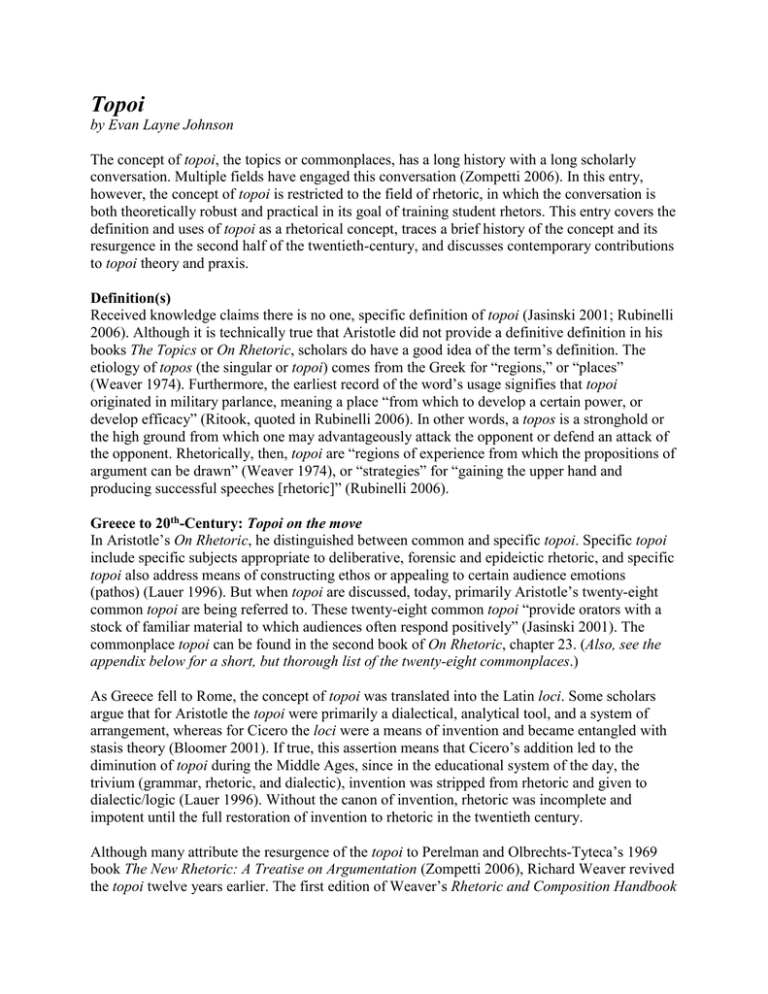
Topoi by Evan Layne Johnson The concept of topoi, the topics or commonplaces, has a long history with a long scholarly conversation. Multiple fields have engaged this conversation (Zompetti 2006). In this entry, however, the concept of topoi is restricted to the field of rhetoric, in which the conversation is both theoretically robust and practical in its goal of training student rhetors. This entry covers the definition and uses of topoi as a rhetorical concept, traces a brief history of the concept and its resurgence in the second half of the twentieth-century, and discusses contemporary contributions to topoi theory and praxis. Definition(s) Received knowledge claims there is no one, specific definition of topoi (Jasinski 2001; Rubinelli 2006). Although it is technically true that Aristotle did not provide a definitive definition in his books The Topics or On Rhetoric, scholars do have a good idea of the term’s definition. The etiology of topos (the singular or topoi) comes from the Greek for “regions,” or “places” (Weaver 1974). Furthermore, the earliest record of the word’s usage signifies that topoi originated in military parlance, meaning a place “from which to develop a certain power, or develop efficacy” (Ritook, quoted in Rubinelli 2006). In other words, a topos is a stronghold or the high ground from which one may advantageously attack the opponent or defend an attack of the opponent. Rhetorically, then, topoi are “regions of experience from which the propositions of argument can be drawn” (Weaver 1974), or “strategies” for “gaining the upper hand and producing successful speeches [rhetoric]” (Rubinelli 2006). Greece to 20th-Century: Topoi on the move In Aristotle’s On Rhetoric, he distinguished between common and specific topoi. Specific topoi include specific subjects appropriate to deliberative, forensic and epideictic rhetoric, and specific topoi also address means of constructing ethos or appealing to certain audience emotions (pathos) (Lauer 1996). But when topoi are discussed, today, primarily Aristotle’s twenty-eight common topoi are being referred to. These twenty-eight common topoi “provide orators with a stock of familiar material to which audiences often respond positively” (Jasinski 2001). The commonplace topoi can be found in the second book of On Rhetoric, chapter 23. (Also, see the appendix below for a short, but thorough list of the twenty-eight commonplaces.) As Greece fell to Rome, the concept of topoi was translated into the Latin loci. Some scholars argue that for Aristotle the topoi were primarily a dialectical, analytical tool, and a system of arrangement, whereas for Cicero the loci were a means of invention and became entangled with stasis theory (Bloomer 2001). If true, this assertion means that Cicero’s addition led to the diminution of topoi during the Middle Ages, since in the educational system of the day, the trivium (grammar, rhetoric, and dialectic), invention was stripped from rhetoric and given to dialectic/logic (Lauer 1996). Without the canon of invention, rhetoric was incomplete and impotent until the full restoration of invention to rhetoric in the twentieth century. Although many attribute the resurgence of the topoi to Perelman and Olbrechts-Tyteca’s 1969 book The New Rhetoric: A Treatise on Argumentation (Zompetti 2006), Richard Weaver revived the topoi twelve years earlier. The first edition of Weaver’s Rhetoric and Composition Handbook was published in 1957, and reprinted in 1967 and 1974. Thus, Weaver helped end the tradition of composition professors sending students to study with logicians, and instead re-incorporated some classical topoi theory into his textbook. But only so much can be taught in one freshman course, so Weaver streamlined the topoi to fit our three basic ways of creating assertions to fit “our interpretation of the phenomena of existence”: through assertions of “being, cause, and relationship” (Weaver 1974, 137). Weaver concluded, “No useful end would be served by going over Aristotle’s list of topics minutely,” with freshman, “for there is doubt as to whether [Aristotle] arranged them systematically” (137). Thus, Weave treated the topoi selectively to find “the ones most widely understood and most effective in persuading” (137). As an entry into classical theory, then, Weaver arranges a fourth of the common topoi in descending order of importance, by argument from 1. definition, 2. cause and effect, 3. circumstance, 4. similitude, 5. comparison, 6. contrast, 7. testimony, 8. authority (137). Contemporary Contributions Following Weaver and Perelman’s recuperated the topoi, there has been significant theorization. Lauer argues all the scholars studying topoi divide into four camps (for all four camps herein, see Launer 1996). The first camp sees topoi as a memory aid, a schema, a mnemonic device. Using Toulmin’s argument system, this group also sees topoi as a warrant connecting premises and conclusions. The second group of scholars sees topoi as epistemic, or a means of knowledge creation through critical thinking. The third group, in the dialectical tradition, argues topoi are a form of inferential argument designed to reach probable truth. And the fourth camp views the topoi as heuristic—a socially shared instrument for creating probable knowledge. Another systematic study of topoi was Sara Rubinelli’s article, in which she argued for four distinct types of topos (for all types herein, see Rubinelli 2006). The first type is the subjectmatter topos. For example, Cicero uses the adtributa as a topos specifically regarding commonplace arguments about people, including their name, character, manners, education, etc. The second type of topoi, is the topos of argument scheme: “a procedure for establishing or refuting propositions” (255-6). The third type is topos-as-argument, or what the Romans called the speech division of confirmatio. This was the place in the speech for forwarding the positive arguments for the case, before refuting opposing arguments. Lastly, the fourth type of argument Rubinelli describes is the generic topoi, or the locus communis. These are topoi that are not only common, but fit several similar cases. Finally, in the recent article “The Value of Topoi” argues, “the topoi should have a vital role in contemporary argumentation theory” in four areas (Zompetti 2006, 15). First, the author argues the topoi locate arguments, or are a source of invention (all info in this paragraph, Zompetti 2006). Second, topoi build arguments, or help the rhetor arrange the argument once it has been discovered in the inventional stage. Third, “Topoi offer us a systematic, organized process whereby we can acquire, interpret, manage and use information (in the form of arguments) critically” (23). One byproduct of organized, systematic, and managed knowledge, is that the rhetor will have a better memory. Thus, these first three areas intersect the classical canons of invention, arrangement and memory. The fourth area to value the topoi is in argument pedagogy, since no other method or rubric can “offer the instructor the ease and utility of topoi when teaching issues related to argument” (24). In other words, the topoi are versatile, timeless, and indispensible. Bibliography Aristotle, Omer, and George A. Kennedy. On rhetoric: A theory of civic discourse. Oxford University Press, 2006. Bloomer, W. Martin. “Topics,” in Encyclopedia of Rhetoric (Ed. Sloane), 779-782. Oxford; New York: Oxford University Press, 2001. Print. Jasinski, James. “Topics/Topoi,” in Sourcebook on Rhetoric: Key Concepts in Contemporary Rhetorical Studies, 578-582. Thousand Oak, Calif.: Sage Publications, 2001. Print. Kennedy, George Alexander, ed. On rhetoric: A theory of civic discourse. Oxford University Press, 1991. Lauer, Janice. “Topics,” in Encyclopedia of Rhetoric and Composition: Communication From Ancient Times to the Information Age (Ed. Enos), 724-726. New York: Garland Pub., 1996. Print. Leff, Michael. "Up From Theory: Or I Fought the Topoi and the Topoi Won." RSQ: Rhetoric Society Quarterly 36.2 (2006): 203-211. Mortensen, Daniel E. "The Loci of Cicero." Rhetorica 26.1 (2008): 31-56. Pullman, George L. "Rhetoric and Hermeneutics: Composition, Invention, and Literature." Journal of Advanced Composition 1994: 367. Rubinelli, Sara. "The Ancient Argumentative Game: Τóπoι and Loci in Action." Argumentation 20.3 (2006): 253-272. Weaver, Richard M., and Richard S. Beal. A Rhetoric and Composition Handbook. New York: Morrow, 1974. Print, 136-155. Zompetti, J. "The Value of Topoi." Argumentation 20.1 (2006): 15-28. Appendix: Aristotle’s 28 Commonplace Topoi 1. From opposites a. Look for the truth and falsity in opposites. 2. From grammatical form a. Use different forms of the same words to make distinctions or nuance an argument. 3. From correlatives a. Ask, “What is predicated by a concept/idea/action? What is its pairing? What causes are strongly correlated with this effect? 4. From more and less (fortiori) 4a: From analogy 5. From looking to the time (a fortiori) a. Past vs. Present (e.g. What was true in past is more true in present) 6. From turning the argument on the opponent a. turn the attack against the attacker 7. From definition: a. Define what something is; argue about essence. 8. From varied meanings (of one word) 9. From division 10. From induction 11. From the authority of precedent on a matter a. Appeal to the authority of a judge or to the precedent on the matter, especially in forensic rhetoric (“legal authority” 2.23.12) 12. From subordinate parts a. Examples: argue multiple species are part of one genus, or argue an attack on one part is an attack on the whole. 13. From the consequence a. (“. . . exhort or dissuade and accuse or defend and praise or blame on the basis of the consequence,” 2.23.14) 14. From contrasting opposites 15. From hypocritical deception a. Such as when your opponent says one thing openly and another secretly (“. . . the most effective topic in dealing with paradoxes” 2.23.16) 16. From consequences by analogy a. (e.g. from 2.23.17: If one’s opponent argues that tall boys are “men” and should thus serve in the army, then one may respond that short men are “boys,” and cannot serve.) 17. From results to causes a. If two situations have the same result, argue those situations resulted from the same cause. 18. From contrasted choices: a. Make a claim and give reasons; then reverse the claim and argue from the other side. 19. From identifying purpose with cause a. Argue that since we use something in one way, therefore that use must be the reason for the existence of that thing. 20. From reasons for and against a. Compare the various motivations for action for or against an issue. 21. From the implausible a. People are inclined to believe the probable, and are therefore not surprised when they find what they are looking for. But, if something previously thought implausible occurs, humans have all the more reason to believe the validity of the fact, since it was doubtful in the first place and cuts against the observer’s paradox. 22. From contradictions a. If your opponent contradicts him or herself, exploit the discrepancy and refute them. 23. From the cause of a false impression a. Argue that the other person is mistaken about the facts and offer a remedial explanation; or observe the opponent’s bias, and argue their perspective is skewed. 24. From cause and effect a. “The cause and that of which it is the cause go together, and without cause there is no effect” (2.23.25). 25. From a better plan a. “. . . see if there was or is a better plan of a different sort from what is advised or is being done or has been done; . . . for no one willingly and knowingly chooses the bad” 2.23.26). 26. From comparison of contraries a. Compare the proposal (new plan) with what has been done before (old way). 27. From what would have been a mistake a. (“. . . accuse or defend on the basis of what would have been a mistake” 2.23.28) 28. From the meaning of a name a. Construct an argument based on the meaning and significance of someone’s name.
